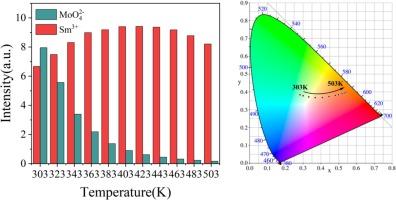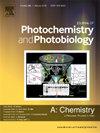Optical thermometry based on different luminescence thermal responses of matrix and doped ions in CaMoO4: Sm3+ phosphors
IF 4.1
3区 化学
Q2 CHEMISTRY, PHYSICAL
Journal of Photochemistry and Photobiology A-chemistry
Pub Date : 2024-09-21
DOI:10.1016/j.jphotochem.2024.116044
引用次数: 0
Abstract
In this experiment, Sm3+ doped CaMoO4 phosphors of scheelite structure with body-centered tetragonal phase were acquired via hydrothermal method, and the Sm3+ doping concentrations were 0.05 %, 0.1 %, 0.3 %, respectively. The temperature-dependent emission spectra of phosphors show that as the temperature rose from 303 K to 503 K, the luminescence intensity of MoO42− decreased all the time due to the thermal quenching, while the luminescence intensity of Sm3+ exhibited a new phenomenon of initial increase and then decrease. The reason for the above new situation is the combined effect of the enhanced energy transfer efficiency of MoO42− to Sm3+ with increasing temperature and the thermal quenching effect of Sm3+ luminescence. The FIR of Sm3+ and MoO42− can be utilized to represent the temperature and achieve optical temperature sensing with high relative sensitivity. The maximum relative sensitivity of CaMoO4: 0.3 %Sm3+ phosphor is 6.07 % K−1 at 303 K. In conclusion, CaMoO4: Sm3+ phosphor has great potential for development in temperature-sensitive materials.

基于 CaMoO4:Sm3+ 荧光粉中基质离子和掺杂离子不同发光热反应的光学温度测量法
本实验通过水热法获得了掺杂Sm3+的白钨矿结构的CaMoO4荧光粉,该荧光粉具有体心四方相,Sm3+掺杂浓度分别为0.05%、0.1%、0.3%。荧光粉随温度变化的发射光谱显示,当温度从 303 K 上升到 503 K 时,MoO42- 的发光强度因热淬灭而一直下降,而 Sm3+ 的发光强度则出现了先上升后下降的新现象。出现上述新情况的原因是随着温度的升高,MoO42- 向 Sm3+ 的能量传递效率增强和 Sm3+ 发光的热淬灭效应共同作用的结果。可以利用 Sm3+ 和 MoO42- 的 FIR 来表示温度,实现高相对灵敏度的光学温度传感。CaMoO4: 0.3 %Sm3+ 荧光粉在 303 K 时的最大相对灵敏度为 6.07 % K-1。
本文章由计算机程序翻译,如有差异,请以英文原文为准。
求助全文
约1分钟内获得全文
求助全文
来源期刊
CiteScore
7.90
自引率
7.00%
发文量
580
审稿时长
48 days
期刊介绍:
JPPA publishes the results of fundamental studies on all aspects of chemical phenomena induced by interactions between light and molecules/matter of all kinds.
All systems capable of being described at the molecular or integrated multimolecular level are appropriate for the journal. This includes all molecular chemical species as well as biomolecular, supramolecular, polymer and other macromolecular systems, as well as solid state photochemistry. In addition, the journal publishes studies of semiconductor and other photoactive organic and inorganic materials, photocatalysis (organic, inorganic, supramolecular and superconductor).
The scope includes condensed and gas phase photochemistry, as well as synchrotron radiation chemistry. A broad range of processes and techniques in photochemistry are covered such as light induced energy, electron and proton transfer; nonlinear photochemical behavior; mechanistic investigation of photochemical reactions and identification of the products of photochemical reactions; quantum yield determinations and measurements of rate constants for primary and secondary photochemical processes; steady-state and time-resolved emission, ultrafast spectroscopic methods, single molecule spectroscopy, time resolved X-ray diffraction, luminescence microscopy, and scattering spectroscopy applied to photochemistry. Papers in emerging and applied areas such as luminescent sensors, electroluminescence, solar energy conversion, atmospheric photochemistry, environmental remediation, and related photocatalytic chemistry are also welcome.

 求助内容:
求助内容: 应助结果提醒方式:
应助结果提醒方式:


